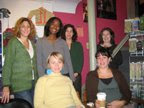Why Spring? I know I'm not alone in looking at last year's Sheep and Wool Festival stash as I see this year's Festival approaching. My goal recently has been to spin something I bought last year before I go to buy more this year.
Toward that end, last week I returned to this:

It moved to the wheel shortly after that photo was taken, and then stayed there unattended for 10 months or so. It's Blue-Faced Leicester from Earth Songs Fiber.
I didn't really remember much about what I'd been trying to do--I know I didn't have a particular project in mind, but was there a weight I was aiming for? I settled for something vague, like "not too skinny."
The roving was dyed quite irregularly, which pleased me, since (if you recall Part 1) one of the things I struggle with in my spinning is the urge to micromanage. If the colors were regular--in sequence or in spacing or anything--I'd be trying to arrange for them to be evenly distributed in the finished yarn, splitting the roving to create two hypothetically equal plies, etc.
Instead, I just sat myself down and started in.
While I spun, two thoughts kept recurring. The first was, "This is only 4 ounces of roving, but it feels like it's taking forever to spin. Isn't that a sign that I'm spinning too thin a strand?"
The second was about randomness. That's what everyone wants in a multi-colored yarn, right? There are so many complaints about what the colors "do" when the yarn is knit up. Do they streak? Stripe? Pool? Zigzag? Unless the design is specifically written around the particular color effect of the particular yarn, frustration is everywhere. Because very few yarns have truly random color distribution: machines may vary how long each color segment is, but seldom the color sequence; hand-dyers work with yarn wound into hanks, which pretty much guarantees some fixed intervals of color.
When I spin from a roving, however, the situation is different. First, roving is dyed (or, more often, painted) as a single long strand. So, although the dyer has the option to use a repeating color sequence, there's no need to do so. And even if the color sequence repeats, the interval doesn't have to--in a sequence like ABCACDABCACDABCACD, each area of B may be larger or smaller than the previous one.
Then there's the question of how I spin that roving. I can pull a short tuft off the roving, and the strand I spin from it may all be virtually the same color. Or I can pull off a longer tuft, then split it lengthwise into 2 or more sections; in this case, I'll get shorter lengths of color, and the sequence of colors from that tuft will repeat 2 or more times before I go on to the next. Or I could split the entire roving multiple times before I even begin to spin, creating multiple repeats of one long color sequence. (There's a spinning project in progress with which I took that technique. I'll show you sometime. There are 2 finished skeins of yarn so far, each maybe 1 ounce, and probably 12 plastic bags with roving in various states of splitting, each with a label like "B4." I started it in May '98 with the idea of knitting a sweater for our first child. I can't imagine why it's not finished yet, can you?)
Anyway, my point is that there are a lot of ways for disorder--randomness--to enter the yarn as I spin it.
So I'm spinning along, making a bobbin of yarn that looks something like this,
and musing upon the word "aleatory" ("subject to unpredictable causes," more or less, from the Latin word for dice), and the next morning, when I come downstairs, I find that the dog has done this with the roving:
Add one more to the list of ways that disorder can enter handspun yarn. (If you'd like your yarn to be less predictable, Truffle can visit your house, too.)
My first thought as I surveyed the wreckage? "Oh, bother, now I have to learn how to Navajo-ply." Navajo plying lets you make a three-ply yarn from one continuous strand, and you have control over where the colors come together, so you can keep the colors distinct or blend them as you prefer. (There's a good illustration here.) Did you notice that word, "control"? This whole letting-go thing really doesn't come naturally for me.
But I figured that the already-not-very-bright colors of the roving were going to merge into mud if I didn't do something to separate them a bit, so I tried it. The results? Much more awkward and messy than you can see here
or here

or here

In fact, it looks kind of cool (as long as you keep your distance), and also when it's wound:

What's it going to be when it grows up? Altogether, the two skeins total maybe 225 yards, and it knits to about 5 to 5.5 sts per inch (on average) on US #6s. I figured that that gauge put me in good shape for some half-fingered gloves. This proved to be a serious miscalculation. But more on that next time.



No comments:
Post a Comment